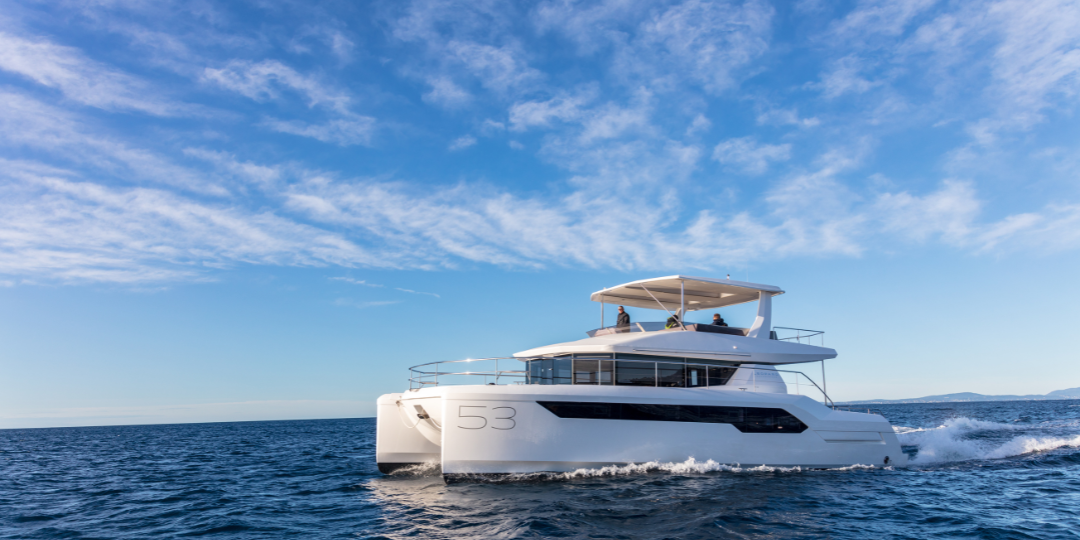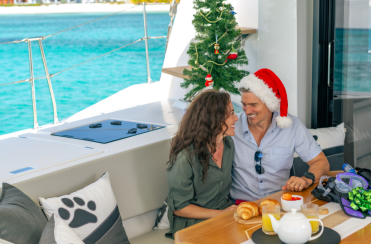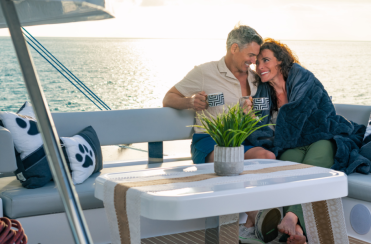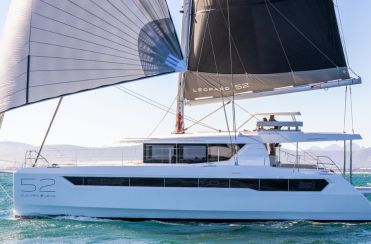
When boating folks talk about circumnavigating the globe, they generally think about doing so under sail. Sailboats use wind for fuel and handle well in offshore conditions, right?
Many who consider circling the globe on a power assume that a trawler or other slow-displacement boat is the way to go. How else can you do it without massive fuel tanks and a slow, efficient hull design?
Well, you know what happens when we assume.
Don Richards and his wife, Anja, are currently making a circumnavigation in their Leopard 53 Powercat. We caught up with them in Tahiti as they prepared for the next leg of their journey.
-4.png?width=1080&height=540&name=Untitled%20design%20(12)-4.png)
Coming from a monohull
This is Don and Anja’s second circumnavigation. That first experience, made in a monohull sailboat, shaped their plans for their current adventure, including the decision to make the odyssey in a Powercat.
“Mainly, I got tired of sailing and grinding winches,” Don told us. “I’m nearly seventy. I’m done raising the mainsail.”
He also noted that while sailors spend a great deal of time under sail on longer transits, once they arrive at a destination, most of their shorter trips—between islands, for example—are under power. So why not just motor all the time?
“The biggest difference once you arrive at a destination,” he adds, “is the Powercat is a floating apartment compared to a monohull. It’s a lot more comfortable.”
-3.png?width=1080&height=540&name=Untitled%20design%20(17)-3.png)
Powercat passage making
The Richards picked up their new Powercat 53 at the Leopard facility in Cape Town, South Africa. They spent a lot of time there making measured runs, logging fuel consumption and building realistic performance curves for passage making. Their work paid off, and their load and consumption tables were accurate throughout their Atlantic and Pacific crossings.
The couple travels at a leisurely pace to maximize range. Don and Anja do most of their crossings and passages at seven knots, which gives them a range of close to 1,700 miles. At nine knots, by comparison, their range drops to 1,000. They’ve installed reserve tanks with an extra 100 gallons (400 liters) of fuel but never needed those reserves for cruising. The Richards filled two 290-gallon (1,100L) fuel bladders carried on deck for a few very long passages.
Of course, the Powercat’s ability to cruise at 18 knots comes in handy when rough weather looms, the customs office is closing, or nightfall approaches.
“A big difference between powering and sailing is knowing when you’ll get there,” Don says. Since you’re not subject to the vagaries of light air and wind direction, planning is much more accurate and predictable under power.
The passage west
The Richards are Australian and may eventually bring their Powercat back to Australia. Like most cruisers, however, they write their plans in wet sand at low tide, so they’re still determining when or if they’ll finally get it Down Under.
Of course, the shortest straight-line distance from Cape Town to Australia is east, across the Indian Ocean, but that is not a recommended route. Prevailing wind patterns, currents, and weather make a passage east from Cape Town unpleasant and possibly dangerous.
“We spoke to a lot of experienced delivery captains and skippers. And they all said clearly, do not go east,” says Don.
Instead, they headed north and west across the South Atlantic. They envisioned heading up through the Caribbean to the U.S. East Coast and over to Europe to cruise the Mediterranean. But the realities of hurricane season and insurance needs kept them south, and they found themselves headed towards Panama and passing through the canal.
On their last circumnavigation, Howard and Anja didn’t make it to Central America or Mexico, so they headed north after coming through the Panama Canal to see it this time. Eventually, they set out from Puerto Vallarta, Mexico for French Polynesia, where they made landfall after a 2,710-mile leg to Hiva Oa. Almost all of that was powering straight on the rhumb line.
Cruising differences
The most notable differences when cruising with a Powercat instead of a monohull are the onboard space and comfort. There’s no comparison with a monohull for the comfortable living space on a stable platform with a full-sized galley. The other is redundancy. You’ve got two engines in two hulls, so there’s always a second engine if one has trouble.
The Powercat also changes where and how the Richards anchor since they can tuck in closer to shore inside the keelboats. Anchoring in shallow water with more protection from shore is almost always better, and moving short distances between anchorages is quick and comfortable.
Hauling the Powercat out of the water takes a little more planning. Like a sailing catamaran, you have a lot more beam and need a travel lift to handle the size. But the bridge deck and cross beams are stout, and Robertson and Caine, builders of the Leopard Powercat, were always available with helpful instructions for where to best place the straps for the safest lift.
Where to next?
The Richards’ current plan is to head to Samoa and likely spend the cyclone season in New Zealand. Next year, they may visit Vanuatu, New Caledonia, and stop at Norfolk Island. Like all their plans, these may change with the conditions.
“We’d also love to head over the top of Australia back to southeast Asia,” Don says. “Maybe the Solomons, Papua New Guinea. Australia’s always an option, too. Who knows?”
When asked one thing potential Powercat cruisers should know, Don’s answer was unequivocal: “You need to know that you can get almost anywhere with the standard tanks. Sure, you’ve got to slow it down. But don’t think you’ll be limited by fuel if you don’t want to be.”
No limits. Sounds like the perfect mantra for world cruisers.
-3.png?width=1080&height=540&name=Untitled%20design%20(15)-3.png)
-3.png?width=1080&height=540&name=Untitled%20design%20(18)-3.png)



